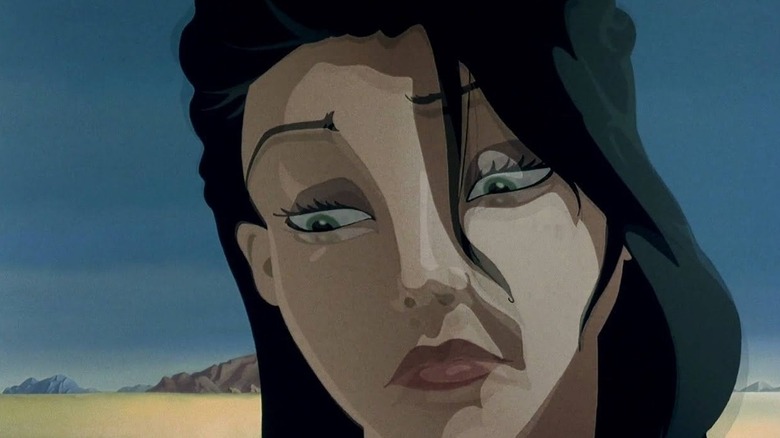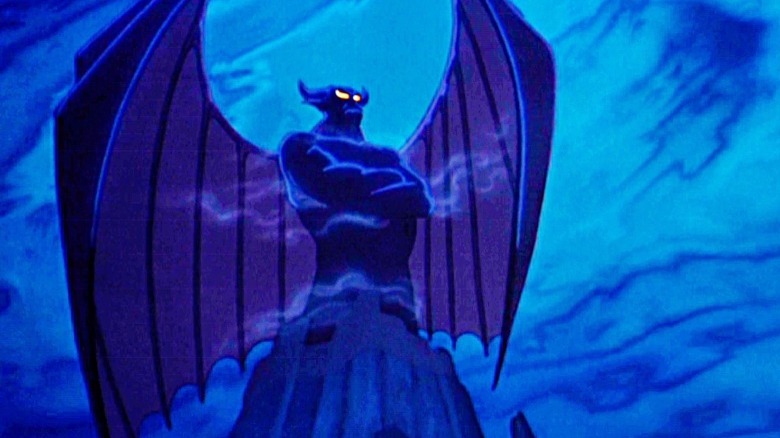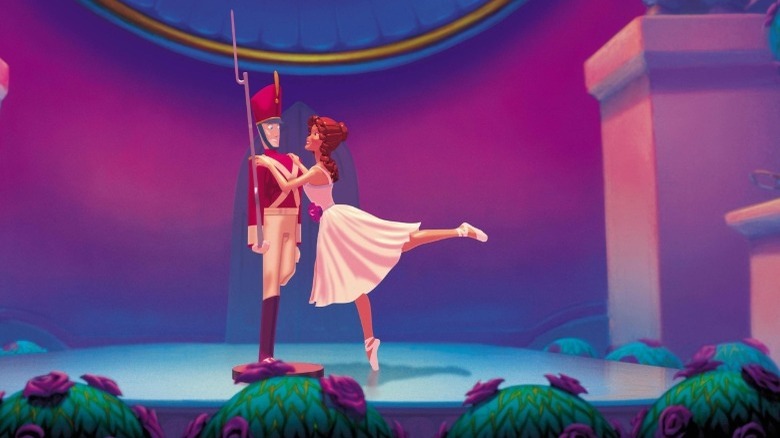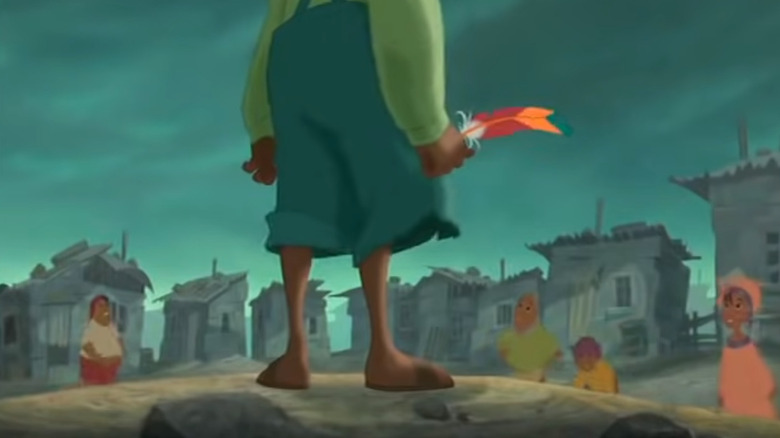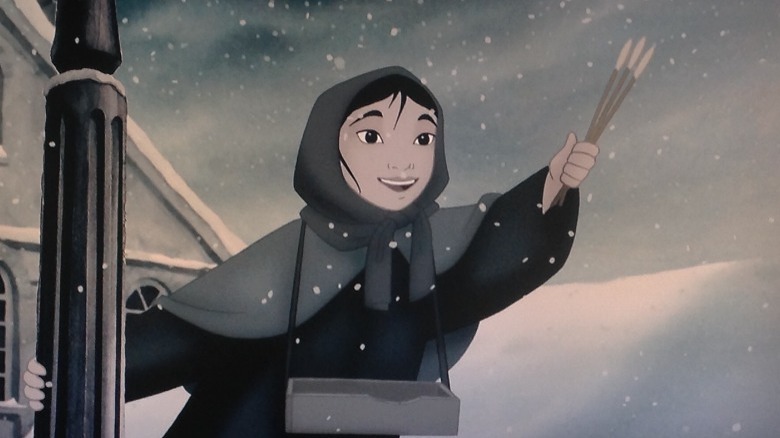Why Disney Closed The Curtain On Fantasia 3
"Fantasia" was always something of a cursed dream, whether the man behind the wheel was Walt Disney or his nephew Roy E. Disney. In 1940, the anthology of short animated films set to classical symphonies was the backdrop to immense innovation in the world of animation, which had already been redefined by Disney in feature films like "Snow White and the Seven Dwarves" and "Pinocchio." However, "Fantasia" was different, bold in its design and marriage of disparate forms, with no conventional narrative.
It was a passion project for Walt, who saw that it could be the "birth of a new concept," according to John Culhane's 1983 book, "Walt Disney's Fantasia." Not only was it hugely, prohibitively expensive, but the ongoing war in Europe essentially cut profit margins in half by preventing its overseas distribution.
Disney had always planned on "Fantasia" evolving through the years, with new pieces replacing old pieces, creating, effectively, a living film. Instead, nearly 60 years would pass before there was any kind of official follow-up. In 1999, Roy Disney was given the chance to serve as executive producer on the film, called "Fantasia 2000," following a successful release of the original film on home video. Despite the lack of attention given to "Fantasia" by the studio over the decades, the dream hadn't died.
Like its predecessor, "2000" failed to generate proportionate interest from audiences. Quietly, however, the work continued.
The lead-up to Fantasia 2000
When "Fantasia" failed to find profits commensurate with its ambition or cost, Walt's plans for a sequel were shuttered, but the studio's chief animators continued brainstorming sequences. By the early 1980s, some of Disney's older animators had conceived of a follow-up called "Musicana," to focus on world music and jazz. However, when Michael Eisner was installed as CEO of Disney in 1984, few things could have been less appealing to the struggling, cash-strapped corporation than an avant-garde and costly animated film. "Musicana" died on the vine.
Roy E. Disney continued to fight for a sequel over the next several years, convincing Eisner to go along with him. According to James B. Stewart's book "Disney War," Eisner even met with legendary composer Leonard Bernstein about working on the film's music, but chairman Jeffrey Katzenberg was incredibly hostile to the idea. When the studio's fortunes turned around with the release of massive, innovative hits like "The Little Mermaid" and "Beauty and the Beast," Eisner was able to cut a deal with Roy Disney: should the 1991 home video release of "Fantasia" be successful, a sequel would be greenlit. The release was indeed successful, and Eisner allegedly called Disney's widow Lillian to tell her "Fantasia" had finally made a profit.
Fantasia failures
After that 1991 release, many years were spent sculpting of the sequel, as it underwent multiple titles and weathered the changing tides of the industry. The studio's strides forward in computer generated imagery over the previous decade would be used as a cornerstone, because the synthesis of CGI and hand-drawn animation had led to gorgeous work in "Beauty and the Beast." Eisner and Disney wanted the release to be an event, and "Fantasia 2000" was the first feature-length animated film to see an IMAX release, in the first couple months of 2000.
Its handsome production and complicated studio backstory aside, "2000" simply didn't make much of an impact. Enough time had passed since the resurgence of interest that accompanied the original's rerelease that the sequel barely broke even at the box office. As with the original film, reviews were mixed. The tepid reaction played a huge part in the inter-company drama that would result in Roy Disney's own departure from the company in 2003 and the eventual ousting of Eisner in 2005.
Despite that failure, work began on a new "Fantasia," according to Collider, even though it never led to an actual film release. Moving on from the strictly classical design of both the original and "2000," the film project, called "Fantasia 2006," would involve different genres of music, harkening back to the work the company had done with "Musicana" in the 1980s. It even went back further, back to a collaboration between Walt Disney and surrealist master Salvador Dali in the 1940s.
What happened to Fantasia?
"Fantasia 2006" never did get completed, but it was lucky to have some major progress made, in the form of four short films. There's no accurate accounting of why the project was shelved, but it surely owed to the behind-the-scenes drama ensnaring Disney in the early 2000's, as well as firings in the company's animation department. When the "Fantasia" series' biggest champion, Roy E. Disney, resigned from the board in the fall of 2003, he made his own personal issues with CEO Michael Eisner public. Among them it became clear that after 19 years of working together, he had had enough of Eisner's "micromanagement" and failure to secure the future of the company.
With his role as chairman of the company's Feature Animations division, Disney had fostered strong relationships with its chief creatives. In a letter drafted by key figures in the films of the Disney Renaissance, the division put their weight behind Roy and against Eisner, claiming:
Now, skilled craftsmen go unemployed while the executive ranks swell. A unique American art form, the Disney cartoon feature, hangs precariously in the balance – reduced to the production of cheap direct-to-video franchise extensions made by committee.
The letter was co-signed by 4,500 present and former Disney animators. According to James B. Stewart's "Disney War," Eisner shut down the company's entire Orlando animation unit as retaliation, yet another knock against the division that had given the company its greatest successes. Collider notes that Disney historian Jim Hill says "the cutbacks at Walt Disney Feature Animation... pretty much stopped any serious development of possible new sequences for the third Fantasia film."
Destino and other tales
What remains of "Fantasia 2006" is staggering.
Only four pieces from the planned film could be completed before the shelving of the project in 2004 (per Disney Animation Archive), and they were slowly doled out through the Disney machine. The first release was "Destino" in 2003 –- a stunning, six-decades-in-the-making surrealist piece that incorporated imagery from Salvador Dali. It came from a meeting between Dali and Walt Disney in 1945, and the years of creative collaboration they shared afterwards, discussing pictures never to be made.
Besides "Destino," there was another special piece that took decades coming to life: "Lorenzo," a film about a cat losing its tail, which was attributed to an idea from Disney story artist Joe Grant in 1949. "One by One," featuring music by Lebo M, follows a group of children in South Africa as they are inspired by a colorful feather.
The last of the "Fantasia 2006" shorts premiered at 2006's Annecy International Animation Film Festival: "The Little Matchgirl," from a story by Hans Christian Andersen, whose work was one of the primary influences on Walt so long ago. These four pieces (all but "One by One" are available on Disney Plus) demonstrate even greater artistry and thematic diversity than the work made for "Fantasia 2000." They epitomize the "Fantasia" ideals of the old art meeting the new, and make any viewer regret that the film was never finished.
